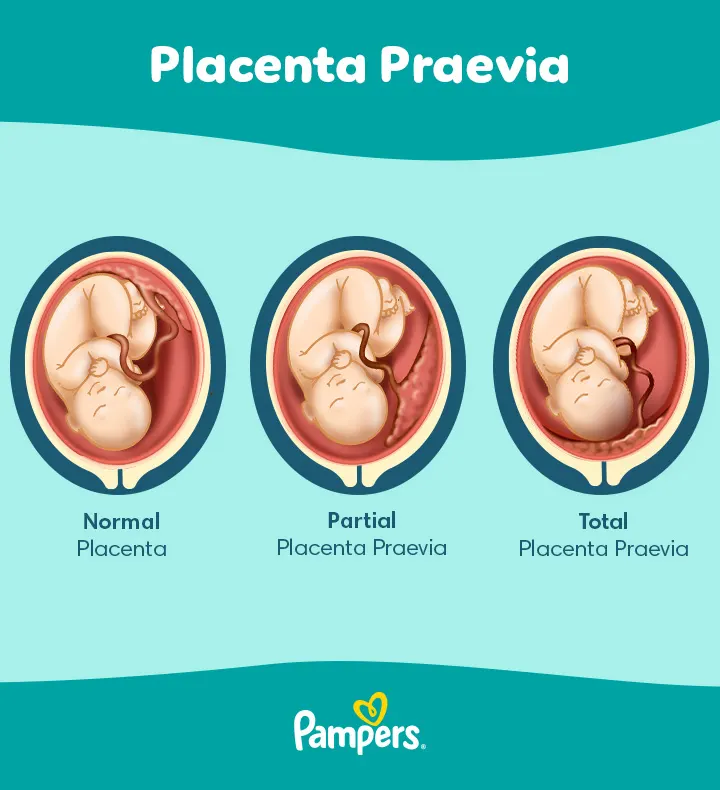
Placenta Praevia: What Is It and What to Do?
Placenta praevia, also known as a low-lying placenta, is a condition that affects a small percentage of pregnant individuals. It occurs when the placenta grows in an abnormal position. This organ plays a crucial role in providing nutrients and oxygen to the foetus, while also removing waste. Continue reading to learn more about placenta praevia, the symptoms and how to effectively treat and manage it.
What Is a Placenta and What’s Its Role in Pregnancy?
The placenta is an organ that forms inside your uterus with your baby during pregnancy, serving as a crucial connection between you and your baby. The placenta attaches to the wall of the uterus, typically positioned at the top or side, and connects to the baby through the umbilical cord.
The main function of the placenta is to supply oxygen and nutrients to your developing baby. It also helps remove waste products from the baby's bloodstream. Additionally, the placenta produces vital hormones to support the pregnancy and serves as a protective barrier against certain harmful substances. After the baby is born, the placenta is expelled from the body in a process known as afterbirth.
What Is Placenta Praevia and How Does it Affect Pregnancy?
In most pregnancies, the placenta attaches to the side or top part of the uterus. However, placenta praevia is a rare condition where the placenta is located low in the uterus. The types of placenta praevia include the placenta partially covering the cervix (known as partial or low-lying placenta praevia) or completely covering it (simply referred to as placenta praevia or total placenta praevia). This condition can lead to severe bleeding during delivery or even while still pregnant.
Many individuals diagnosed with a low-lying placenta early in their pregnancy often find that it moves upward as the uterus expands. However, if the placenta is low in the uterus and covers the cervix, the chances of placenta praevia moving after 32 weeks are unlikely. Additionally, if you have had a previous caesarean section, this may decrease the chances of the placenta moving upward.
Symptoms of Placenta Praevia
The main sign of placenta praevia is painless bleeding from the vagina that commonly occurs in the second half of the pregnancy. Call your GP or midwife if you experience any vaginal bleeding in your second or third trimester of pregnancy or if you experience contractions. Seek emergency medical care if bleeding is severe.
Causes of Placenta Praevia
The exact causes of placenta praevia are not fully understood, but several potential risk factors have been identified. These may include:
Understanding these risk factors may help in monitoring and managing potential complications during pregnancy.
Potential Risks and Complications of Placenta Praevia
Your doctor and midwife must monitor both you and your baby to reduce the risk of complications. The possible placenta praevia risks are:
Placenta Praevia Diagnosis
If you have placenta praevia, it will typically be detected during your regular antenatal checkups or during your 18 to 21-week ultrasound scan. To confirm the diagnosis or to obtain more detailed information, your doctor or midwife may perform a transvaginal ultrasound. This involves using a wand-like device that is gently inserted into the vagina.
Should your doctor or midwife suspect or notice any signs of placenta praevia, then they may do additional ultrasounds to determine the precise location of the placenta, whether it is low-lying, and assess whether it can resolve itself over the course of your pregnancy.
However, if you experience any heavy bleeding during your pregnancy, go to your nearest hospital immediately.
How Common Is Placenta Praevia and Who Is at Risk?
Placenta praevia is a relatively rare condition, occurring in about 1 in 200 pregnancies. Some risk factors for developing placenta praevia include a previous history of the condition, having had prior pregnancies, being over 35, undergoing surgeries that may have left scars on the uterus (such as caesarean sections or fibroid removals), carrying multiple babies at once, and engaging in smoking or drug use.
Treatment Options for Placenta Praevia
If you do have placenta praevia, the treatment options may depend on the severity of the condition; how much bleeding you have; how far along your pregnancy is; the position of the placenta; and to what extent it actually covers the cervix. Your doctor or midwife will monitor whether the placenta praevia resolves itself, which is common by weeks 32 to 35 of pregnancy. But if it doesn’t, they will aim to get you as close to full term as possible.
If you’re late into your pregnancy and you still have placenta praevia, a C-section may be required. If your placenta is positioned low but does not cover the cervix, you may still be able to have a vaginal birth. Your doctor and midwife will discuss the safest options for you and your baby.
In any case, the most important thing you need to do is take care of yourself, rest as much as possible, and avoid any activities that may trigger bleeding, like exercise.
Whilst, understandably, you may worry about placenta praevia, know that it’s a rare condition, and even if you’re diagnosed with it or show signs of it, there is a good chance it will resolve on its own. If it does not resolve, your doctor can manage the condition to ensure the safety and health of both you and your baby.
Can You Naturally Move the Placenta Up?
It is not possible to naturally move the placenta during pregnancy. However, if the placenta is low-lying in the early stages, such as in cases of placenta praevia, it may move upward on its own as the uterus expands. In most cases, this occurs by the third trimester when the growing uterus pulls the placenta away from the cervix, and no treatment is necessary.
There are no exercises or lifestyle changes that can physically shift the placenta. Regular monitoring through ultrasounds is usually recommended to check the position of the placenta as the pregnancy progresses.
The Bottom Line
Placenta praevia is a condition that requires careful monitoring during pregnancy, but it often resolves on its own as the uterus expands. Regular antenatal care, including ultrasounds, is essential for tracking the position of the placenta and ensuring the safety of both you and your baby. If the placenta remains low-lying later in the pregnancy, your doctor and midwife will recommend the best course of action, which may include a planned caesarean delivery to avoid complications. Staying informed and collaborating closely with your healthcare team can help manage placenta praevia and support a healthy pregnancy outcome.
If you’re currently on your pregnancy journey, download the Pampers Club App to save on every purchase of Pampers nappies and wipes you make in the future.
How We Wrote This Article The information in this article is based on expert advice found in trusted medical and government sources, such as the National Health Service (NHS). You can find a full list of sources used for this article below. The content on this page should not replace professional medical advice. Always consult medical professionals for full diagnosis and treatment.
Read more about Pregnancy
Related Articles
Join Pampers Club and get:















